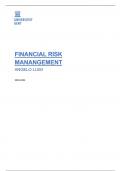Summary
Samenvatting Financial Risk Management door Angelo Luisi - 2023/24
- Course
- Institution
- Book
Summary of the course “Financial Risk Management” by Prof. Angelo Luisi at Ghent University. The summary includes info from the slides, supplemented with notes from the lessons and info from the book. With this, I made it 17/20.
[Show more]




